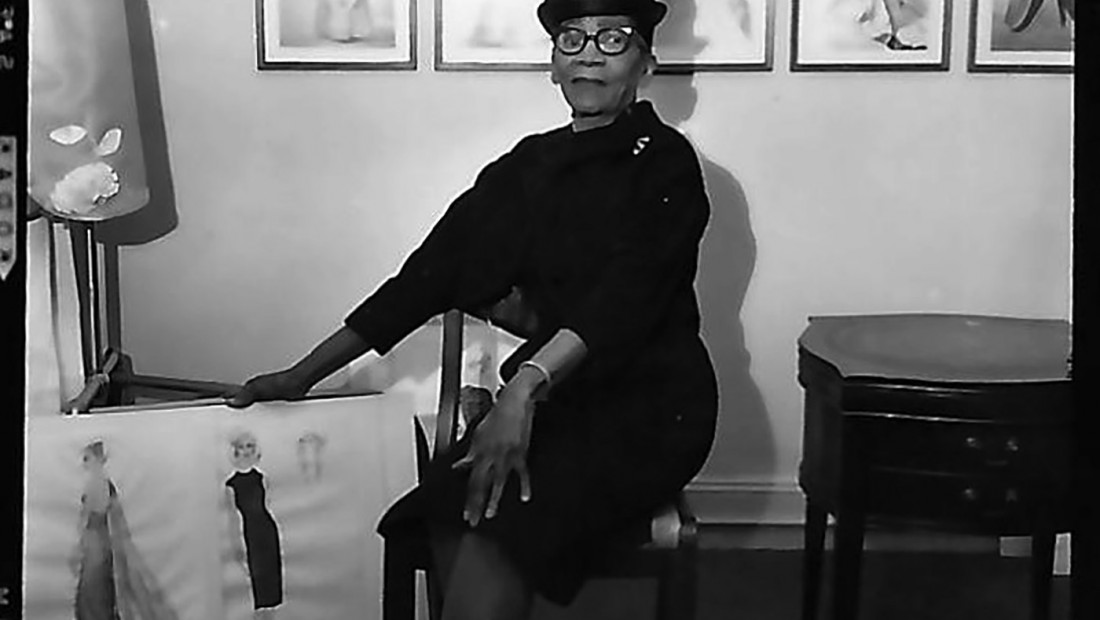A couture dress in a thrift store, a story about race

Related link
Celebrating Ann Lowe dress reveal event
Subscribe to Inspire
Apple Podcasts | Spotify | YouTube | Stitcher
Subscribe to the Inspire Podcast Newsletter
Transcript of Podcast
Intro: So much history hides out in closets or goes to landfills each year. Ohio State’s Historic Costume & Textiles Collection is now making a concerted effort to collect the clothing and stories of people of color. If you have historic or contemporary clothing that has special meaning or was worn to recent Black Lives Matter protests, we’d like to add your pieces to the museum. Contact Gayle Strege at strege.2@osu.edu.
Robin: Because life and people aren’t as neatly packaged as history would have us believe, you don’t have to scratch very far beneath the surface to find some hard truths. As so, when The Ohio State University found itself in possession of a treasure crafted by the woman regarded as the first Black fashion designer in the United States, we decided to take a deeper look — at her life, and at racism in an industry that touches everyone, as near to us as the clothing on our backs.
It all started with a phone call.
Gayle Strege: Last summer I was contacted by a man who volunteers for the first community village thrift store.
Robin: That’s Gayle Strege, curator of Ohio State’s Historic Costume and Textiles Collection. Gail Strege: And he said that they had an Ann Lowe dress in their collection and did I know who that was? And was I interested in that dress? And of course, I was like, “No, yeah, sure. You've got an Ann Lowe dress.”
Robin: Ann Lowe. The designer and maker of the wedding dress worn by Jacqueline Bouvier in her marriage to John F. Kennedy in 1953. Couturier for the du Ponts, the Rockefellers, the Roosevelts and high society in the 1950s and 60s. And because she was Black, a designer whose
genius went largely unheralded until after she died in 1981. And last summer one of her creations turned up in a thrift store in a suburb of Columbus, Ohio.
(Music)
Robin: This is the Inspire, a podcast produced by Ohio State University’s College of Education and Human Ecology. I’m Robin Chenoweth; Carol Del Grosso is our audio engineer. Curator Gayle Strege was intrigued when she got a call that an Ann Lowe dress was in a resale shop in Upper Arlington, Ohio. So she made an appointment with the store director.
Gayle Strege: She actually didn't have the dress at the store at the time. She had it at her house. But she had pictures of the dress and there was a label on the dress that said Ann Lowe for AF Chantilly.
Robin: A quick internet search reveals that A.F. Chantilly is the label that Ann Lowe used from late 1960s, near the end of her career.
Gayle Strege: And I was like, well, yeah, it's, you know, Ann Lowe. That's amazing. How did you come by getting this dress? And she said it was donated to them along with other pieces that also had A.F. Chantilly labels.
Robin: Those other dresses were made by Florence Cowell Gayle: So she was the F in A.F. Chantilly
Robin: Florence’s son, Jim Gessner, ran the business that housed the label. His mother made day dresses and suits. Ann Lowe made evening gowns and wedding dresses. Gessner kept the remainders of the New York shop after it closed and donated the clothing to the thrift store associated with his church in Upper Arlington, Ohio.
Robin: Two donors quickly offered funds to buy the dress, which now resides in Ohio State’s collection. We had to go see for ourselves.
Robin: We’re at Ohio State University's historic costume and textile collection, in the storage room surrounded by racks upon racks of clothing. 12,000 pieces in fact, worn by famous people, or made by famous designers or even alumni. Everything is tagged with labels about designers and donors and the eras that they were worn. It's a fascinating place to look around. Robin: And there was the gown, dressing a mannequin in the middle of the space, as if it were a fancy ballroom.
Gayle: A very plain dress for the most part, it has a slightly high waistline and it just has narrow shoulder straps. It's very much of a 60s sheath-style but the bottom of the dress is where there's the most design element.
Robin: Handmade stems, leaves and flowers, appliqued in sprays building downward to the bottom hem. Lowe learned to make the blossoms in her grandmother’s dress shop in Alabama, where her family made clothing for the governor’s wife and other elite customers. Picking up scraps of fabric from the floor, the young Ann fashioned them into these beautiful works of art that became a signature of her designs.
Gayle Strege: You can actually see in some of the leaves, the pencil lines have been used to cut out the designs. And then the edges are finished.
Robin: The dress is one of perhaps 60 in museum collections in the United States, a fraction of the work Lowe designed during the half century or more that she worked. Part of the reason: She wasn’t given much credit for the designs she created. When Jacqueline Kennedy was asked by reporters who made her iconic wedding dress, for example, she simply replied — and I’m quoting here — “a colored dressmaker did it.”
Tasha Lewis: Her handiwork, her craftsmanship was really impeccable.
Robin: Tasha Lewis graduated with a master’s in fashion and retail studies from Ohio State in 2000. Now an associate professor of fiber science and apparel design at Cornell University, she is among a tiny minority of faculty of color in the field.
Tasha Lewis: And just the idea that she'd cater to wealthy, white women and socialites, and no one really knew who she was. She should probably be up there with Oscar de la Renta or Carolina Herrera in terms of who her clientele were, but at the time not being acknowledged, and not given any type of credibility for what she was doing.
Robin: The fact was, Lowe had encountered significant racism while learning her craft and building her business. In 1917, patrons in Florida helped the young seamstress get accepted into a top-notch design school in New York. But when she arrived, the instructors forced her to work in a space separate from her white classmates, who refused work in the same room with her.
Elaine Nichols: Segregation was the accepted norm and it was legal at that point in time. So they could do that. And they did.
Robin: Elaine Nichols, is a curator at the Smithsonian Institute’s National Museum of African American History and Culture, which has 26 Ann Lowe creations.
Elaine Nichols: As it turns out, she knew more than the students and possibly even the professors at the school. They started to use her work as an example for the students, and basically said that there wasn't anything that they could teach her.
Robin: Ann Lowe went back to Florida. Patrons helped her to set up a shop and she eventually hired many seamstresses to help her with the intricate beadwork and sewing of her creations. But the lure of the big city was great. And so she went back to New York, where her designs began to be recognized by people like the Rockefellers and the Bouviers. But it was also where she was taken advantage of.
Elaine Nichols: She was a gifted artist. Business management was not her strong suit.
Robin: Lawyers at high-end clothing retailers drew up contracts that barely compensated her for the labor-intensive work she did. Patrons talked her down on her prices.
Elaine Nichols: I think some of it is human nature that people want to get the best bargain, the best price they can for themselves. I think some of it is absolutely based in a culture that has devalued the work of African Americans, and so it made it all right to take advantage of her by acquiring a gown or suit at a price that was substantially lower than what you would have paid for a Dior gown or suit. I think we rationalize that kind of behavior.
Robin: Lowe even lost a lot of money on the Kennedy wedding after pipes burst in her workroom, destroying the voluminous gown and several bridesmaid dresses ….. 10 days before the wedding. She recreated them, hiring extra help and paying out-of-pocket for new fabric.
Researcher Margaret Powell estimated that Lowe lost money on each dress she made while working for department stores in New York. She ended up declaring bankruptcy in 1963.
Elaine Nichols, 26:48: And one of the largest claims against her was from Saks Fifth Avenue, something like $9,000, $10,000. And this is in the early 1960s. That's not a small amount of money.
(Music)
Robin: Not until after the civil rights movement would any single Black designer break into the upper echelon of fashion. And then there were just a few. In 1974, Stephen Burrows and eleven Black models were among the Americans who famously blew up Paris fashion at the Battle of Versailles design show — a great movie to stream, by the way. But then, after that, not much again until the 1990s. Why? Fashion by its nature has been the business of exclusion, says Tasha Lewis.
Tasha Lewis: So the idea of even who the gatekeepers are. Who are the tastemakers? We have a sense of fashion coming out of Europe or being aware of fashion houses, or this idea of who gets to talk about fashion. That's definitely part of what we are dealing with in terms of equity. Who gets to dictate what is fashionable and what is in fashion? And do we associate black people and people of color with those images of fashion?”
Robin: The arbitrators have been white, and mostly male: Christian Dior. Yves Saint Laurent, Karl Lagerfeld. Halston. The museum curators, the design school faculty, the models and even the mannequins used to display the clothing. White. The industry is so monochromatic, Lewis found in her research, that when hip-hop began touting designer brands like Gucci 20 years ago, many of those labels said, thanks, but no thanks.
Tasha Lewis: There was this idea of hip-hop artists embracing, luxury brands, and calling them out in their songs. And some of the brands that they would mention kind of distancing themselves and sort of saying, you know, that's not really our customer base. They didn't want to alienate their traditional customer from the brand. We're consumers, but maybe we're not an image that a brand wants to put forth. And I think those are the challenges, the issues with stereotyping the issues with cultural appropriation, those are all evidence that you don't have enough people of color sitting in your decision-making executive seats to at least say, hey, maybe this isn't a good idea, or this is not right.
Robin: And yet, people of color have always been in the background, honing the art of fashion design, putting their unique mark on it, pushing themselves to the forefront. People like Niccole Hairston Jones. She’s a 2006 graduate of the fashion and retail studies program who interned with Donna Karan. Her career has taken a few turns.
Nicholle: I did some freelance work and ended up opening up a millenary shop. Robin: Oh, cool. So you mean hats?
Nicholle: Yeah, yeah, yeah, I did some freelance work for Victoria's Secret. And we had a project when they were open up their flagship store in New York, on Lexington. They did a lot of hat boxes. And it just kind of sparked the interest of headwear that I just had not come across prior to. And so I just kind of took to it.
Robin: She had some brisk e-commerce, the high-tea set in Britain and Australia; the red-hat societies in the South. Then, in 2018, she got a master of fine arts, online, at the Academy of Art University in San Francisco, and earned a coveted spot on a runway at New York’s Fashion Week that year. There weren’t too many classmates who looked like her in that art college. But as a student, she went searching for Black designers, looking for inspiration. She found Ann Lowe and felt a connection.
Nicholle: The images that I saw, she would have her glasses on her hat and just be posed in just a particular way that somewhat resembled Chanel.
Robin: Oh, yeah, you're right. I didn't make that connection until you said it.
Nicholle: Yeah, Chanel, she knew what she was doing. And very particular about things and followed her instinct. And that was what I got from Ann, that same confidence. It really stood out because of the fact that I can only imagine some of the struggles that she had to endure during her period of time.
Robin: Both Lowe and Jones had grandmothers who led them into the trade.
Nicholle: My grandmother, her name was Louise. She was an exceptional tailor. Exceptional. I've heard stories from my mom where she would hand my grandmother a pattern late in the
evening, and pick out some fabric and say, Hey, can I wear this tomorrow? and my grandmother would put it together, sew all the way through the evening. And my mom would wake up, and she had this suit that fit her to the tee.
(Music)
Nicholle: I look at some of the things that I do. And I personally strive, because I feel like my grandmother didn't necessarily have the opportunity or resources to fully shine or take her skill to the next level.
Robin: Resources such as college, online classes, internships and capital to start a business. Those are all becoming, by degrees, more accessible to people of color. Also, the paradigms for attaining fashion success are shifting. Fashion Week has become more open to designers like Jones. A social media post — like those about Michelle Obama’s outfit for the 2021 inauguration — can send a career into another stratosphere for a Black designer like Sergio Hudson.
Robin: But it’s still really tough for a rising fashion designer, and doubly so for a Black one. Since racial justice protests last summer, fashion experts are sounding the alarm about the industry’s
systemic racism and failure to promote talent of color. In 2018 just 15 out of 500 member designers on the Council of Fashion Designers for America were Black. To move up in that climate, Jones realizes she needs to be where the action is. That’s why she recently sold her house in Ohio, packed her dog and daughter into her car and drove to Florida… to consider relocating there, or maybe even continue on to New York. She’s going for it …. just like Ann Lowe did in the 1920s.
Robin: So, you know who you're sounding like?
Nicholle: Oh, yes, I know right? I'm in, I'm in the southern Orlando area but I was like oh my gosh she was in Tampa! That's why it's sometimes really important to see people that look like you, or just even your sex. You know what I'm saying? Because certain aspects of their life and the history or whatever, it kind of intersects with you and it, I don't know, it just makes it seem possible.
Nicholle: I always felt that I was continuing something. And as I stand, Ann Lowe's beside me, my grandmother's beside me, all the seamstresses that did beautiful work and, didn't necessarily get credit for it. They create this moment.
Nicholle: You feel a sense of pride. You feel a sense of responsibility that you are going to take it to the next level and fulfill some of the sacrifices and the injustices that occurred in the past — in your own little industry. Everybody's got their industry but, you know, this is mine. And you just want it to change.”
Closer: To get a look at the exquisite craftsmanship of Ann Lowe’s debutante gown in Ohio State’s Historic Clothing and Textiles Collection, join us on March 16 at our YouTube Premier event. Sign up at go.osu.edu/AnnLowe or go to our YouTube channel.




